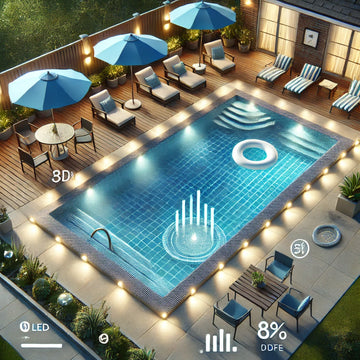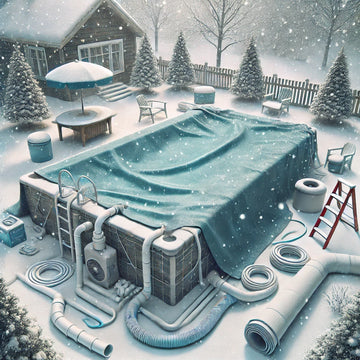POOL LINER REPAIR TIPS FOR FLOATING LINERS
Noticing a big bubble in your liner? Or maybe it’s floating a bit on one side? Don’t panic just yet. Your pool is experiencing pool liner floating. And it’s a common occurrence, especially during the off-season.
To help you address this frustrating issue, here’s everything you need to know about pool liner floating, how it’s caused, how to fix it, and how to prevent it from disrupting your enjoyment of your swimming pool in the future.
WHAT IS POOL LINER FLOATING?
Pool liner floating is when the pool liner material is pushed outward, ballooning, wrinkling, shifting, and floating in the pool.
WHY DOES IT OCCUR?
Floating liners occur when the water volume and pressure around the pool area and behind the pool liner is higher than the water volume and pressure in the pool.
This buildup of water behind the pool liner can be caused by a leak in the pool liner or by an increase in the ground water tables due to heavy rain, snowmelt, and even moderate rain after an extended period of drought.
Pool liner float is most common during the period from fall to spring due to increased precipitation and a decrease in pool water volume. And it also occurs in areas with a soil base that doesn’t allow water to run through it easily—e.g. clay.
WHAT ARE THE POSSIBLE RISKS TO MY POOL & LANDSCAPING?
The buildup of water behind a pool liner can cause damage to the structure of the pool and the surrounding pool landscaping. If you have a concrete deck, you might notice signs of sinking and cracking.
The excess water can also wash away the backfill from around your pool. And the pool walls can rust if made from galvanized steel.
HOW CAN I PREVENT THIS FROM HAPPENING?
Along with following regular pool maintenance and avoiding these common pool maintenance mistakes, you can prevent pool liner floating with these tips.
PERFORM REGULAR SUMP WELL MAINTENANCE
Regularly inspect your sump well and keep an eye out for rising water levels. If the water level in the well is more than 12 inches, use a submersible pump to lower the water slowly to about 3 inches.
The sump well is a basin that catches water from high ground water tables and directs the water away from the pool area. The sump well can usually be found under a cover such as a circular patio stone.
PUMP WATER FROM POOL COVER ONLY DURING DRY PERIODS
You may want to pump the water off your pool cover during the first signs of spring. But keep in mind that the ground water table will be higher, especially during the spring thaw and heavy downpours. And the water on top of your cover will actually help prevent liner float by adding more volume to your pool.
Remember, if there is less water volume in your pool than in the ground surrounding your pool, then pool liner float can occur. And if you pump off all the snowmelt and rainwater from your cover when the ground is already saturated with water, you will increase your chances of liner floating.
So you’re better off waiting until a dry period to pump off the water from your pool cover.
INSTALL A SWIMMING POOL SAFETY COVER
Along with keeping your pool clean and safe for children and pets, safety covers also help prevent the risk of floating liners.
Many covers are designed to allow water to pass through the material and into the pool. So when it rains heavily, or when snow and ice melt on the cover, the water will end up in your pool instead of in the ground surrounding your pool.
HOW DO I FIX IT?
To repair a floating pool liner, you’ll need to determine the source of the excess water and remove the water from behind the liner.
To rule out a leak in your pool liner, determine whether the water level has decreased more than usual and test the water behind the liner for chlorine using a test strip.
And if there is a puddle of water in your backyard, test the puddle for chlorine as well. If the puddle has 3 ppm of chlorine, then the water is most likely leaking from your pool.
In this case, you’ll need to locate the leak and repair the pool liner with a pool liner patch. If you’re not sure how to detect a leak in a pool liner, or how to find the location of the leak, contact the pool experts.
To remove the water from behind the liner:
- Use a liner lock, or wooden clothes pegs with the springs removed, to wedge the liner in the track on either side of the area you will be working on.
- Remove 6 to 18 inches of liner from the track to sleeve a pump suction pipe behind the liner—you can use your pool pump or a service pump to either pump the water into the pool or to an area far away from your pool.
- Place bags of pool salt and weighted bags in your pool to keep the liner in place while pumping the water
The most important areas to keep in place include:
- The shallow end breakpoint—where the shallow end floor begins to slope down to the deep end;
- On both sides of the breakpoint—where the shallow end breakpoint meets the pool walls; and,
- On in-wall steps.
Unfortunately, pool liners will likely have wrinkles after removing the water, so you’ll need to remove the wrinkles as well.
Your liner may also be stretched out and not go back into place once you repair a floating liner. In this case, it’s time to call in the experts in inground pool liner repair.
WHEN TO CALL THE PROS
If you can’t get your liner back to its original position after pumping the water, call in the pros who offer a pool liner service. Ask them, “How much is a new liner for an inground pool?” if you want to replace your pool liner. They can repair your pool liner or replace it altogether.
Repairing or replacing a leaky, wrinkled, or stretched out pool liner will help fix the unsightly damage caused by pool liner floating so you can enjoy your pool to its fullest all summer long.




